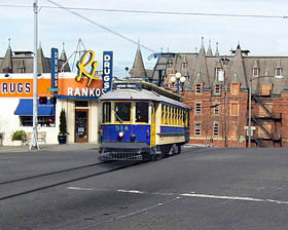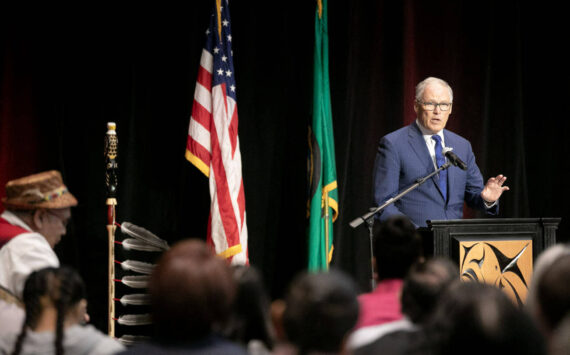EDITOR’S NOTE: Shortly after the Index went to press Wednesday morning, the City of Tacoma announced public works department announced its draft streetcar feasibility resolution would be removed from the city council environment and public works committee agenda. “The streetcar resolution discussion has been postponed to a future meeting to include a larger discussion about a strategic plan for downtown area parking,” announced City of Tacoma engineer Spencer T. Beier. “We will update you when this meeting is re-scheduled.” As such, the online version of this article has been updated to reflect this latest development. –TM
– – – – – – – – – – – – – – – – – – – – – – – – –
Three weeks after findings of a feasibility study examining whether to restore a heritage streetcar system in Tacoma were released, a city council committee, which was expected to review a draft resolution this afternoon aimed to keep momentum going on this grassroots effort, has postponed the item to a meeting July 11 in order to include a larger discussion about a strategic plan for downtown area parking.
Last month, an advisory committee consisting of the city’s public works staffers, neighborhood councils, business districts, Sound Transit, Pierce Transit, and other interested parties concluded a six-month study that showed a streetcar system would be a feasible transportation option for Tacoma, and streetcars elsewhere have spurred investment and economic development in other U.S. cities.
This afternoon, the environment and public work committee was expected to follow up on those findings by reviewing a draft resolution that would build upon that initial study.
The Index has seen a version of that resolution, which calls for a consultant to verify the study’s findings, determine the cost of implementation and possible returns on a streetcar investment with respect to future development, investigate route priorities and future growth plans of the city, and study possible funding sources. It would also direct the streetcar advisory committee to begin a public process to help determine where a streetcar system would operate and how it would be funded.
It is the latest chapter in an effort largely spearheaded by Tacoma Streetcar, a grassroots organization, and dating back more than a year.
Today’s meeting at City Hall follows a May 24 meeting when the feasibility study findings were shared with councilmembers, city staff, and interested parties.
“Clearly, if 100 years ago we could do this, we could do it now,” said Tacoma public works engineering division manager Steve Shanafelt, who was tasked with leading the advisory committee.
He provided examples of three possible streetcar routes that would largely follow original lines that once existed in Tacoma (for maps of these routes, visit http://www.tacomadailyindex.com/pages/streetcar/ ).
Still, Shanafelt cautioned that these were simply suggested routes created by the feasibility group, and based on connections to Link Light Rail, transit ridership volumes in those areas, and development activity along those lines.
“I want to make sure you understand this is not a proposal about where routes should be,” he said. “There needs to be extensive public outreach and more stakeholders involved regarding route selection.”
The biggest hurdle, however, remains financing, according to the study.
The costs of streetcar lines and light rail in other cities have ranged from $11.6 million per mile (Portland, Ore.) to $22.2 million per mile (Atlanta) to $46 million per mile (Denver).
The feasibility group recommended reducing costs by creating routes that share roads with vehicle traffic, selecting restored heritage cars that would be much cheaper than new models, and starting with a single, prioritized route rather than a complex system.
“Unless you can come up with a great big pot of money at once, this should be prioritized,” Shanafelt added.
Other U.S. cities have turned to streetcars to spur economic development.
In Kenosha, Wis., which started operating a two-mile line in 2000, the return on investment has been substantial. According to a study conducted by Reconnecting America, a national non-profit organization formed to link transportation networks and the communities they serve, the system, which cost $6 million, has seen $150 million in planned and existing development directly related to the line (67,500 people rode the streetcar in 2005). In Little Rock, Ark., a 2.5-mile, $19.6 million line has seen $200 million in development investment (ridership totaled 190,000 in 2005). And in Tampa, Fla., a $48.3 million, 2.3-mile line has seen $1 billion in investment tied to its 2003 operation (ridership totaled 435,000 in 2005).
In Portland, streetcars have “been highly instrumental in focusing development in areas where streetcars are located,” said Shanafelt. “Developers are much more willing to invest their own money. We see it as a strong economic development tool.”
Tacoma’s history is inextricably linked to streetcars.
According to History Link, an online encyclopedia of Pacific Northwest history, streetcar roots date as far back as 1885, when businessman Allen C. Mason made a request to City Council for 30-year franchise to build a streetcar system. That request was denied. But in 1887, railroad contractor Nelson Bennett made a similar request, lobbying for a 50-year franchise. Permission was granted, and the City of Tacoma built the tracks. Bennetts steam locomotives were franchised out to real estate promoters who wanted to serve new housing developments in the city’s south and west ends, according to History Link.
The idea to restore Tacoma’s streetcar system has followed a long route through City Hall, dating back to last spring. On April 12, 2006, the environment and public works committee unanimously approved a do-pass recommendation to City Council for a resolution to study the feasibility of developing the streetcar. On July 27, 2006, City Council agreed with that recommendation and unanimously passed a resolution directing city staff to study the idea.
If you would like to attend today’s meeting, it begins at 4:30pm at City Hall, 747 Market St., Room 248. A copy of the agenda is available here: http://131.191.130.69/cityclerk/Files/CouncilCommittees/Agendas/2007/EPWAgenda/EPW_061307.pdf
– – – – – – – – – – – – – – – – – – – – – – – – – – – –
In May, the Index traveled to Rockport, Wash., to visit a 1908 Turtleback streetcar that once operated on Tacoma streets, and is now owned by Historic Railway Restoration. To view photos of the old streetcar, visit http://www.tacomadailyindex.com/pages/rockportst/
rockportst1.jpg — Tom and Vince Mendenhall
rockportst2.jpg — Historic Railway Restoration’s 1908 Turtleback streetcar, which once operated in Tacoma.
rockportst3.jpg — Inside the old Turtleback streetcar.
rockportst4.jpg — A chipped and flaked door handle reveals nearly a century of wear-and-tear on the old Turtleback streetcar.
rockportst5.jpg — A 1919 Birney model streetcar (left) sits near a 1908 Turtleback streetcar on 40 acres in Rockport, Wash.
rockportst6.jpg — Steel siding runs the Turtleback streetcar’s length.
ALL PHOTOS COPYRIGHT (C) TODD MATTHEWS / TACOMA DAILY INDEX
– – – – – – – – – – – – – – – – – – – – – – – – – – – –
For earlier streetcar coverage, visit the Index’s archives for the following articles:
— Building History: A father-and-son team puts heritage trolleys back on city streets (June 1, 2007)
— End of the line, 130 miles north (May 31, 2007)
— City Council committee onboard with streetcar feasibility results (May 24, 2007)
— Streetcar Desires: Tacoma isn’t the only city giving heritage transportation a new look (Jan. 17, 2007)
— Group kicks off feasibility study for Tacoma streetcar (Dec. 19, 2006)
— Home Town Spirit: An interview with Tacoma Streetcar’s Morgan Alexander (Sept. 19, 2006)
— City moves forward on streetcar feasibility study (June 28, 2006)
— Council committee supports streetcar resolution (April 13, 2006)








